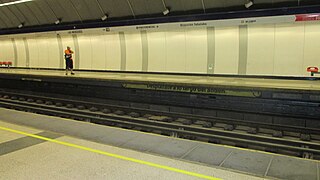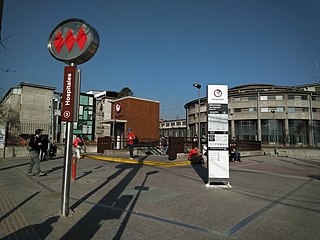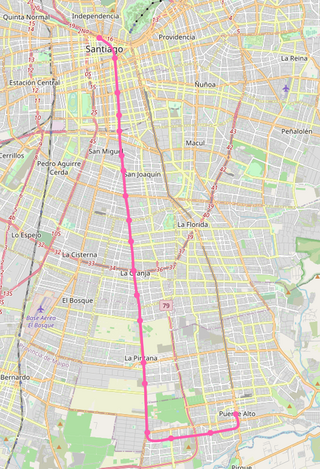
The Santiago Metro is a rapid transit system serving the city of Santiago, the capital of Chile. It currently consists of seven lines, 143 stations, and 149 kilometres (92.6 mi) of revenue route. The system is managed by the state-owned Metro S.A. and is the first and only rapid transit system in the country.

Empresa de los Ferrocarriles del Estado is the national railway and the oldest state-run enterprise in Chile. It manages the infrastructure and operating rail services in the country.

Enrique Víctor Aquiles Balmaceda Toro was a Chilean politician, diplomat and son of President José Manuel Balmaceda. He was of Basque descent and a member of the Balmaceda family.

Los Héroes is a rapid transit station of the Santiago Metro system, being an interchange point in between Line 1 and Line 2. It located at the intersection of Avenida Libertador General Bernardo O'Higgins and the Norte-Sur branch of the Autopista Central, which is considered the kilometre zero of Chile.

Bustamante Park is an urban park in Providencia, Santiago de Chile. It is built on the former site of Pirque railroad station and adjacent classification yard. The park is bounded by Providencia Avenue on the north, just south of Plaza Baquedano, and Marín Street on the south.

Los Quillayes is an elevated metro station on the Line 4 of the Santiago Metro, in Santiago, Chile. It named for the neighborhood where it is located. The station was opened on 30 November 2005 as part of the inaugural section of the line between Vicente Valdés and Plaza de Puente Alto.

República is an underground metro station on the Line 1 of the Santiago Metro, in Santiago, Chile. This station is named for República Avenue. The station was opened on 15 September 1975 as part of the inaugural section of the line between San Pablo and La Moneda.

Avenida Vicuña Mackenna is one of the main transport arteries of Santiago, Chile, joining Santiago center with more remote urban centers such as the communes of La Florida and Puente Alto.

Santiago Metro Line 2 is one of the seven rapid transit lines that currently make up the Santiago Metro network in Santiago, Chile. It has 26 stations and 25.9 km (16.1 mi) of track. The line intersects with Line 1 at Los Héroes, with the Line 3 at Puente Cal y Canto, with Line 4A at La Cisterna, with Line 5 at Santa Ana, and Line 6 at Franklin. It will also intersect with the future Line 7 and Line 9 at Puente Cal y Canto. Its distinctive colour on the network line map is banana yellow.

Santiago Metro Line 4 is one of the seven lines that currently make up the Santiago Metro network in Santiago, Chile. It has 23 stations and 23.9 km (14.9 mi) of track. The line intersects with Line 1 at Tobalaba, with Line 3 at Plaza Egaña at northeast, and with Line 4A at Vicuña Mackenna and with Line 5 at Vicente Valdés in southeast. It will also intersect with the futures Line 8 at Macul and Line 9 at Plaza de Puente Alto. Its distinctive colour on the network line map is blue.

Santiago Metro Line 4A is one of the seven lines that currently make up the Santiago Metro network in Santiago, Chile. It has six stations and 7.7 km (4.8 mi) of track. The line intersects with Line 2 at La Cisterna, and with Line 4 at Vicuña Mackenna, both being its termini. It will also intersect with the future Line 9 at Santa Rosa station and acts as a link between these two lines. Its distinctive colour on the network line map is light blue.

Las Mercedes is an underground metro station located on Line 4 of the Santiago Metro, in Santiago, Chile. It lies opposite Concha y Toro Avenue between Independencia Street and Domingo Tocornal Avenue. The station was opened on 30 November 2005 as part of the inaugural section of the line between Vicente Valdés and Plaza de Puente Alto.

Protectora de la Infancia station is an elevated metro station located on the overhead section of Line 4 of the Santiago Metro, in Santiago, Chile. It named after the Protectora de la Infancia children's charity, whose headquarters are just opposite the station.

Hospital Sótero del Río station is an elevated metro station located on the overhead section of Line 4 of the Santiago Metro, in Santiago, Chile. It is named after the Sótero del Río Hospital, which is directly surrounding the station. The station is located in Concha y Toro Avenue near its junction with Gabriela Avenue.

Line 3 is a rapid transit line of the Santiago Metro. Traveling from La Reina in the east towards the center, and Quilicura in the North, Line 3 was originally intended to open in the late 1980s, but the 1985 Algarrobo Earthquake hampered its construction, and a subsequent urban explosion in Puente Alto and Maipú further put its construction on hold, until in the early 2010s construction started. The first phase of the project includes 18 stations, which were completed and opened to the public on 22 January 2019 at a cost of US$1.79 billion. The second phase, composed of a three-station extension towards the main square of Quilicura, which was inaugurated on September 25, 2023 with a total project cost of US$378 million. Its distinctive color on the network line map is chocolate brown.

Santa Rosa station is an embanked metro station located on Line 4A of the Santiago Metro in Santiago, Chile, between the La Granja and San Ramón stations and also between the communes of the same names La Granja and San Ramón. It lies along the Vespucio Sur Freeway, on its junction with Santa Rosa Avenue. The station was opened on 16 August 2006 as part of the inaugural section of the line between Vicuña Mackenna and La Cisterna.

Plaza de Puente Alto is an underground metro station and the southern terminal station of Line 4 of the Santiago Metro network, in Santiago, Chile. The station is located under the square of the same name, Plaza de Puente Alto, parallel to Concha y Toro Avenue at the junction with Manuel Rodríguez avenue in the commune of Puente Alto. The station was opened to the public on November 30, 2005 as part of the inaugural section of the line between Vicente Valdés and Plaza de Puente Alto.

La Granja station is an embanked metro station located on Line 4A of the Santiago Metro in Santiago, Chile. It lies between the Santa Julia and Santa Rosa stations in the commune of the same name, La Granja, and is located along the Autopista Vespucio Sur highway at the junction with Coronel Street. The station was opened on 16 August 2006 as part of the inaugural section of the line between Vicuña Mackenna and La Cisterna.

Hospitales is an underground metro station of Line 3 of the Santiago Metro network, in Santiago, Chile. It is an underground, between the Plaza Chacabuco and Puente Cal y Canto stations on Line 3. It is located at the intersection of Independencia Avenue with Profesor Zañartu Avenue. The station was opened on 22 January 2019 as part of the inaugural section of the line, from Los Libertadores to Fernando Castillo Velasco.

Santiago Metro Line 9 will be a new line that will be part of the Santiago Metro and will have an approximate length of 17 kilometers (11 mi), connecting the communes of Santiago in the center and Puente Alto in the south of the Chilean capital.




















